Musings On Roofs
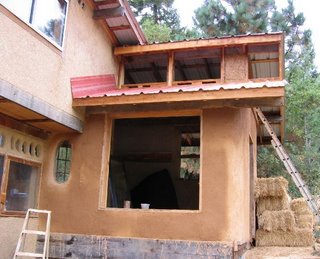
I spent a lot of time on roofs in the past few months, not so much in the past few weeks though. I like being up on roofs a lot, the height and the view I guess. I helped with 5 roofs 4 of them very different from each other. I helped some with the Madrone house roof, mostly over the second bedroom, last year it had plastic over part of it, this year we finished the walls and then put on the rest of the roof, it has a metal roof attached to perlins, thin pieces of wood running between the rafters to screw the roofing to, no plywood or tar paper or anything.
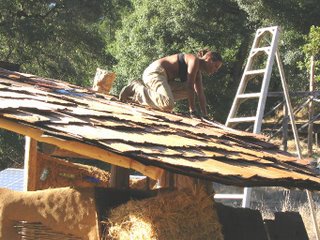
The pump house roof was fun, I really like working with shakes, although figuring out which one will fit well each time you put one up is slow work, it is fun, like a puzzle, and normally there are a bunch that would work, so it really isn't that hard. The hard part about shake roofs is finding wood that is straight enough grained to make shakes with in the first place, it needs to be old growth. Luckily here there are some stumps from old growth trees cut down a long time ago, before chainsaws when they used huge saws which had one person at either end pulling back and forth, and they wanted to cut up higher where the tree was a bit narrower. The pump house roof is not a traditional shake roof, to shed water shake roofs need to be quite steep, and this one is not, so it has very thin plywood with tar paper and sand impregnated roofing on top of it under the shakes. The shakes make it look nicer and will lengthen the life of the roofing under them.

I also worked on Strawberry house's roof which is the most conventional with plywood, tar paper and metal roofing. I have written a bunch about it already so if you want to know more go back and look at older posts. But as you can see in the picture the roofing is up, including the roof caps, which were not up during the first rain, and there is even a window in.
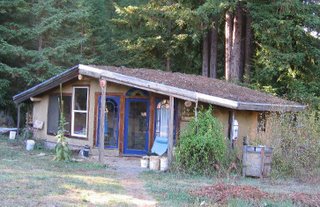
Then, of course, there is the El Nido roof, with it's pond liner and dirt, and soon to be plants, there are already plants sprouting on it. (See previous post for details.)
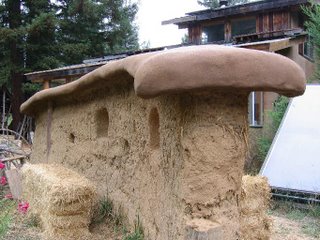
The most novel roof I worked on is the roof over the garden wall. It is an experiment and is cob, (clay soil, sand and straw) on and between small redwood branches and looks mushroom like. The cob was plastered and a drip edge was sculpted to make water drip to the ground at the edge of it instead of running around the edge and under the roof, then a final coat of plaster was put on and after that dried 4 coats of linseed oil were applied. It is cool, I hope it works.
All these different types of roofs have their pluses and minuses and which ones to use depend many things: how much embodied energy (energy it took to extract the resources and manufacture the material and deliver them to where they are used) do the materials have; how long will they last without leaking; how easy are they to replace when they do wear out; how available is the material; how steep do you want your roof; is it important how toxic or nontoxic the roof is; what do you think looks the best; what disturbs the house site least; do you care how visible your house is from above; does it matter if it is hard to get lots of insulation into it; does it matter if the roof helps the house stay cool in the summer; do you want to be able to hang out on the roof; are you interested in rain water collection; is being fireproof important; does it matter how heavy the roof is; etc.
I do not have a favorite, it would depend on the circumstances. I like the living roofs, although I didn't like working with the liner very much, and it did smell bad for you, although once it is covered that goes away. I also like how nice it is to be on, being dirt and not very steep it could be a useful area for living. And it is relatively fire proof. I also really liked the shakes, but finding bits of already dead old growth redwood or cedar is getting harder. Also I have heard they are more likely to leak, at least in the first few rains after a dry period since the wood does shrink and swell with moisture. And you can't walk on a shake roof, you can easily break the shakes that way, another drawback is it is not at all firesafe. Metal is easy and relatively long lasting and leak proof but does have a lot of embodied energy. And the experimental cob roof is not likely to be useful for using on whole buildings. I have been thinking about experimenting with an aluminium soda/beer can roof. Cutting the tops and bottoms off cans and a slit though the resulting tube, then crimping them together edge to edge to make a roll, and laying the roll out in stripes overlaping the one below, with the crimps running up and down. Maybe not for a large structure or a house but to cover a small shed, or the roof over a cob oven.
When asked which type of roof they like both Darryl and Michael say they don't like roofs, Darryl likes the way houses look with just rafters, Michael likes the openness and light in roofless houses (at least that is my impression of their reason). I can relate and think I would want some outdoor enclosed space included in/around a house I built, but I would put a roof of some sort over the house part of the house, and they did too.
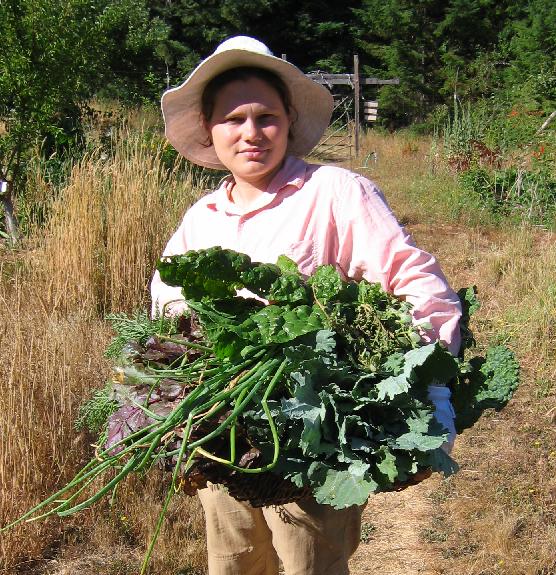

0 Comments:
Post a Comment
<< Home